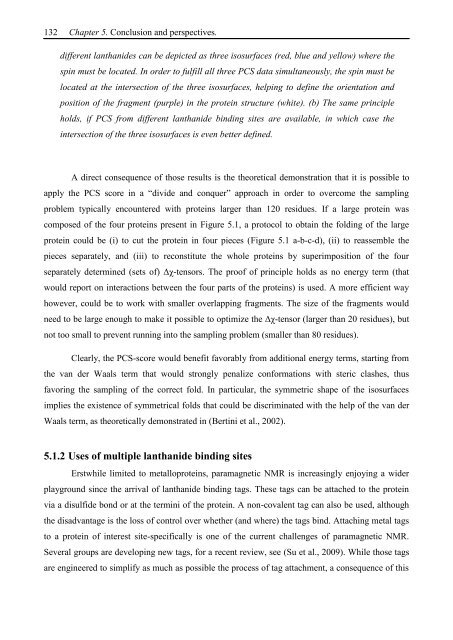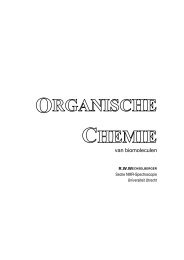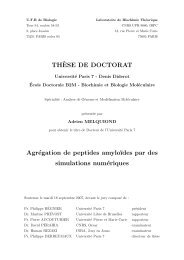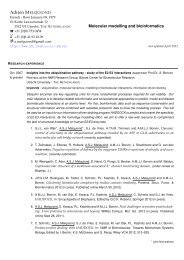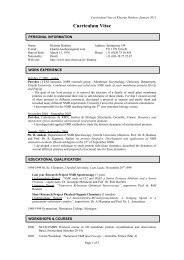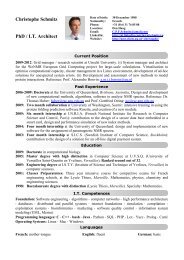Thesis Title: Subtitle - NMR Spectroscopy Research Group
Thesis Title: Subtitle - NMR Spectroscopy Research Group
Thesis Title: Subtitle - NMR Spectroscopy Research Group
You also want an ePaper? Increase the reach of your titles
YUMPU automatically turns print PDFs into web optimized ePapers that Google loves.
132 Chapter 5. Conclusion and perspectives.<br />
different lanthanides can be depicted as three isosurfaces (red, blue and yellow) where the<br />
spin must be located. In order to fulfill all three PCS data simultaneously, the spin must be<br />
located at the intersection of the three isosurfaces, helping to define the orientation and<br />
position of the fragment (purple) in the protein structure (white). (b) The same principle<br />
holds, if PCS from different lanthanide binding sites are available, in which case the<br />
intersection of the three isosurfaces is even better defined.<br />
A direct consequence of those results is the theoretical demonstration that it is possible to<br />
apply the PCS score in a ―divide and conquer‖ approach in order to overcome the sampling<br />
problem typically encountered with proteins larger than 120 residues. If a large protein was<br />
composed of the four proteins present in Figure 5.1, a protocol to obtain the folding of the large<br />
protein could be (i) to cut the protein in four pieces (Figure 5.1 a-b-c-d), (ii) to reassemble the<br />
pieces separately, and (iii) to reconstitute the whole proteins by superimposition of the four<br />
separately determined (sets of) Δχ-tensors. The proof of principle holds as no energy term (that<br />
would report on interactions between the four parts of the proteins) is used. A more efficient way<br />
however, could be to work with smaller overlapping fragments. The size of the fragments would<br />
need to be large enough to make it possible to optimize the Δχ-tensor (larger than 20 residues), but<br />
not too small to prevent running into the sampling problem (smaller than 80 residues).<br />
Clearly, the PCS-score would benefit favorably from additional energy terms, starting from<br />
the van der Waals term that would strongly penalize conformations with steric clashes, thus<br />
favoring the sampling of the correct fold. In particular, the symmetric shape of the isosurfaces<br />
implies the existence of symmetrical folds that could be discriminated with the help of the van der<br />
Waals term, as theoretically demonstrated in (Bertini et al., 2002).<br />
5.1.2 Uses of multiple lanthanide binding sites<br />
Erstwhile limited to metalloproteins, paramagnetic <strong>NMR</strong> is increasingly enjoying a wider<br />
playground since the arrival of lanthanide binding tags. These tags can be attached to the protein<br />
via a disulfide bond or at the termini of the protein. A non-covalent tag can also be used, although<br />
the disadvantage is the loss of control over whether (and where) the tags bind. Attaching metal tags<br />
to a protein of interest site-specifically is one of the current challenges of paramagnetic <strong>NMR</strong>.<br />
Several groups are developing new tags, for a recent review, see (Su et al., 2009). While those tags<br />
are engineered to simplify as much as possible the process of tag attachment, a consequence of this


